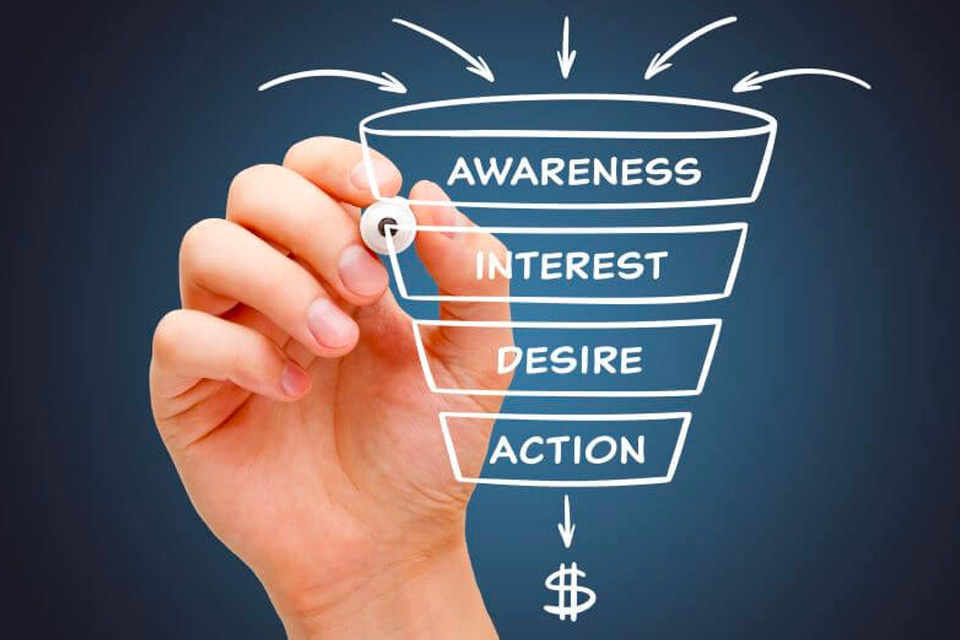The customer journey is complex. Think about the last time you bought something online. Maybe you saw an ad for a product, then you looked at a review, then you did a search. Before customers complete an action on a website—or convert—they interact with your company, product, or service in a variety of ways. Digital marketers describe the journey from awareness to purchase as conversion funnel marketing.
Imagine it like pouring liquid through a funnel. There may be many people who are aware of your brand, but as you get deeper, the number of people who convert will naturally thin out. The goal of your digital presence should be to take as many people as possible from the entry point of the funnel all the way to the bottom. The following tips will help you maximize your conversion funnel marketing.
1. Understand Your Audience and Their Pain Points
Products or services that perform well online present themselves as solutions to a problem. Focus less on the product and the service and more on how that product or service benefits the customer or how it makes them feel. We call this customer-focused language, rather than product-focused language.
Let’s say you run an auto repair shop. An example of product- or service-based language would be, “The best auto repairs in town.” To make this customer focused, bring their attention to how this makes the customer feel, such as, “Get you back on the road.”
If you’re unsure if language is customer focused, try the “we help you” test. This is a simple exercise: just add the words “we help you” to the beginning of your headline or sub-headline. If it makes sense, it is likely customer facing: “We help you get back on the road.” By presenting yourself as a solution, you can enhance your conversion funnel marketing.
2. Utilize a Strong Call to Action
A call to action (CTA) is a piece of text that tells your audience what you want them to do. Calls to action are found in ad copy as well as buttons on your landing page. A CTA can be anything, from “learn more” to “get offer.” It’s important to test a variety of CTAs to see what has the best conversion rate for your product or service.
When you first start a new marketing campaign and are choosing an initial call to action, think about where your audience is in the funnel. Customers that are newly acquainted with your product are more likely to respond well to a CTA such as “learn more” and less motivated to click on a button for “buy now” since they aren’t ready to buy just yet.
In addition to the words you choose, you can also test the color of the call to action button and the placement of the button. Seemingly small actions can have big impacts on conversion rates. With all testing, it’s important to conduct an A/B test—more on that below—to ensure it’s an apples-to-apples comparison.
3. Conduct A/B Tests on Your Landing Page
A landing page is a technical term for a website that ads direct customers to. Typically, landing pages are single pages because studies have shown that single-page websites have significantly higher conversion rates when compared to multi-page websites. However, once you launch landing pages, your work is not done. To ensure top conversion funnel marketing, it’s essential you conduct rigorous A/B testing. A simple A/B test sends traffic to two nearly identical landing pages to measure the difference in performance between the two. You may change something like a headline or the background image or wording of the call to action. Over time, brands see significant gains in conversion rate through consistent A/B testing.
Dig Deeper
Creating A Strategy To Improve Your Social Media Engagement
12 Must-Have Pages On A Business Website
4. Ensure Ad Copy Is Appropriate for Your Audience
Before someone sees a landing page, they are served an ad. A common mistake companies make, particularly in social media advertising, is serving the same ad copy to every audience, regardless of their position in the funnel. Remember what we said about calls to action? When someone may not be ready to be told to “buy now” on the website, they also shouldn’t be told to “buy now” in the ad. When you create an ad, think about where your customer is in your conversion funnel.
Has your customer heard of your product? Has your customer heard of your product but not your company? Is your customer weighing their options in trying to make a decision to purchase after hearing about your company and product? These are all different scenarios that require different ad copy.
Similar to landing pages, ad copy should be tested. This is particularly important on visual platforms such as Facebook or Instagram. You can test different images, as well as headlines or calls to action. As a rule of thumb, conversion rates tend to be higher when calls to action on ads match the call to action on the landing page.
5. Give Them a Reason to Convert
Sometimes, you’re asking someone to make a purchase online, but the goal of most advertising campaigns is information: an email address, a phone number, a name. Their data and time are valuable, so what are they getting in return for providing that information to you? If they are requesting an appointment, ensure that the next steps are outlined clearly and that someone follows up in a timely manner. If someone is signing up for a newsletter, respect their trust and ensure that you only send them the most essential updates. If you’re looking to collect information, a time-tested strategy is to offer something in return, particularly for someone who is in the research phase and is not ready to become a lead. Many companies will offer a brochure or white paper in exchange for contact information and follow-up.
Another approach is offering a discount on products or services rendered if someone signs up, offers information, or calls. Do some research. Take a look at your competitors. What are they offering in exchange for information? Ask your customers if they feel like you connected with them in a timely manner. Customers have some of the best data available to you. All you need to do is ask.




